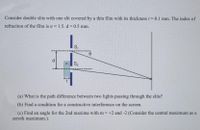Question

Transcribed Image Text:Consider double slits with one slit covered by a thin film with its thickness t= 0.1 mm. The index of
refraction of the film is n = 1.5. d = 0.5 mm.
S,
d
S2
(a) What is the path difference between two lights passing through the slits?
(b) Find a condition for a constructive interference on the screen.
(c) Find an angle for the 2nd maxima with m =+2 and -2 (Consider the central maximum as a
zeroth maximum.).
Expert Solution
This question has been solved!
Explore an expertly crafted, step-by-step solution for a thorough understanding of key concepts.
Step by stepSolved in 2 steps with 2 images

Knowledge Booster
Similar questions
- answer pleasearrow_forwardIn single slit experiment a mixture of red light (632 nm) and blue light (471 nm)shines on the single slit. The centers of the first order bright blue fringes lie at theouter edges of a screen that is located 0.500 m away from the slits. However, thefirst-order bright red fringes fall off the screen. By how much and in which direction(toward or away from the slits) should the screen be moved so that the centers of thefirst-order red fringes will just appear on the screen? (hint L2-L1 =?)arrow_forwardIn the figure below (not to scale), let L = 1.20 m and d = 0.110 mm and assume the slit system is illuminated with monochromatic 510-nm light. P S₂ 6 n L Viewing screen (a) Calculate the phase difference between the two wave fronts arriving at P when 0 = 0.500°. rad (b) Calculate the phase difference between the two wave fronts arriving at P when y = 5.00 mm. rad (c) What is the value of 0 for which the phase difference is 0.333 rad? O (d) What is the value of 0 for which the path difference is λ / 4? Oarrow_forward
- How to slove this questionarrow_forward(B) I Woy The figure shows two patterns projected on screens from shining a laser through a double slit apparatus. The black spots are the light from the laser. What could be the cause of the difference we see between setup A and setup B? Setup A has larger slit spacing or uses a laser with larger wavelength. Setup A has smaller slit spacing or uses a laser with smaller wavelength. Setup A has smaller slit spacing or uses a laser with larger wavelength. Setup A has larger slit spacing or uses a laser with smaller wavelength.arrow_forwardm, and d= 3.00 x 10 m. (B) Determine the distance between adjacent bright fringes. Use the bright fringe equation again to find the distance between any adjacent bright fringes (here, those characterized by m and m + 1). AL AL (m+ 1) - AL Ay = y+1 m%3D (5.63 x 107 m)(1.20 m) - 2.25 cm 3.00 x 105 m LEARN MORE REMARKS This calculation depends on the angle 0 being small because the small angle approximation was implicitly used. The measurement of the position of the bright fringes yields the wavelength of light, which in turn is a signature of atomic processes, as is discussed in the chapters on modern physics. This kind of measurement therefore helped open the world of the atom. QUESTION Which of the following make the separation between fringes greater in the two slit interference experiment? (Select all that apply.) O Larger separation of the two slits. O Narrower slits. Wider slits. O Smaller separation of the two slits. PRACTICE IT Use the worked example above to help you solve this…arrow_forward
- A light with wavelength λ = 565 nm falls on a pair of closely separated slits. The first dark fringe of the interference pattern is at an angle θ = 3.25 degrees from the central maximum. a) Solve for the numerical value of d in mm.arrow_forwardA thin film of oil is on water. What is the thinnest that the oil can be to have constructive interference on reflection? The wavelength of the light in air is 480nm. Assume the beam starts in air. [n =1.00 ,n =1.50 , nwaer =1.33]arrow_forwardA monochromatic source of light of wavelength λ, is incident on a slit of width a. Obtain an expression to represent the angle of the 4th diffraction minimum. Hint: Think about Huygens construction with the single slit divided into four equal length sections acting as sources of secondary waves. Write down a general expression for the nth minimum angle. If λ =500 nm, a = 4 μm, determine the angle of the 2nd minimum.arrow_forward
arrow_back_ios
arrow_forward_ios